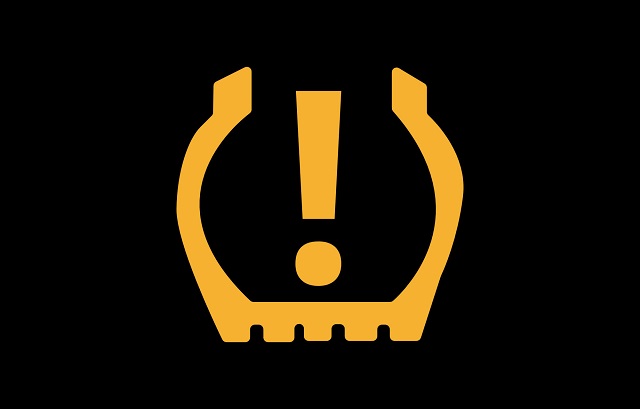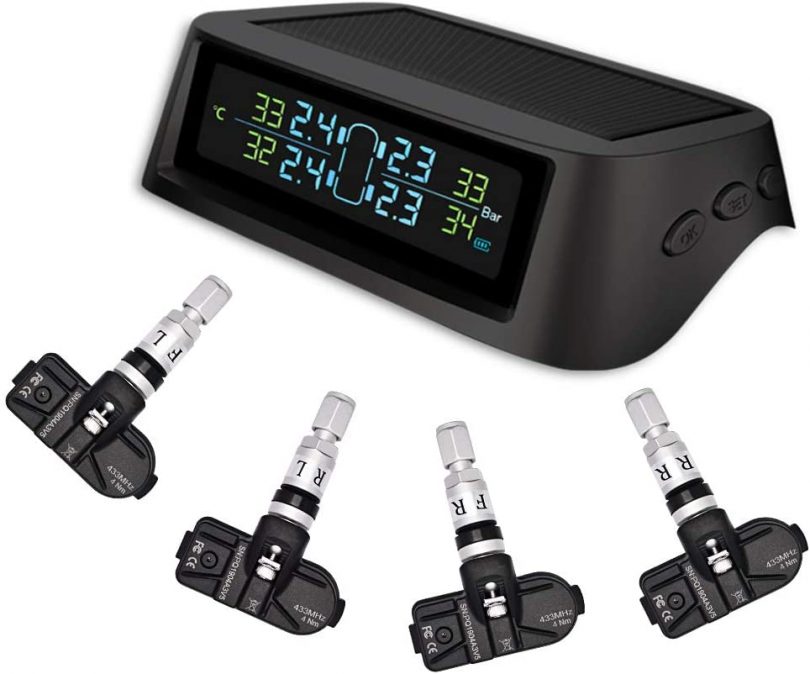The tires are a significant part of your car. They are the ones that directly in contact with the road. Therefore, it is essential to take regular care and maintenance of tires for your car’s safe and durable performance. The tire pressure sensor do the good job for you now a days. Let us know more.
What is a Tire Pressure Sensor?
What is a tire pressure sensor? It is a tire pressure monitoring system or otherwise called TPMS. A tire sensor, a part of the tire pressure monitoring system, is a small electronic device kept inside your car’s pneumatically inflated tires. It continually monitors the air pressure inside the vehicle’s tires—the real-time tire-pressure data sent to the display gadget fitted on the car’s dashboard. The Tire pressure monitoring system thereby alerts the driver in either way by alarming a low pressure warning signal by beep sound, gauge measure of the tire pressure, or the warning display.
We cannot access or measure the tire pressure while moving. The tire is rotating at high speed, and it is exposed to unexpected hazards on the road. Therefore, making a direct connection with the tire is very much challenging. Moreover, the temperature of the tire may be very high. In this challenging situation, only the tire pressure sensor is employed. It needs to be overcome these harsh conditions and needs to do its job to the best.
The sensor fitted inside the tire constantly monitors the tire pressure and sends the data via radio signals to the display gadget equipped in front of the driver. When the pressure inside any of the four tires is low, the sensor triggers the warning light in the display and alert the driver. The tire pressure sensor and the display unit integrated and named as TPMS.
The tire pressure monitoring system’s primary function is to monitor the pressure of the tires constantly and avoid any untoward actions in case of low air.
Tire Air Pressure

The tire pressure measured in pounds in a square inch (PSI). Every car manual details you the tire pressure details of your car. Every tire must have the optimal amount of air inside the tires. Usually, the right tire pressure for a light vehicle like cars ranges between 30 to 35 PSI.
You need to check the tire pressure when the tires are cold. The driving causes the tires to get heated. Therefore, it raises the pressure inside the tires. It is essential to measure the tire pressure either in the morning or when the tire is cold. It is necessary to know tire pressure may vary about 2PSI for every 10- degree variation in the outside temperature.
Maintaining proper air pressure is one of the most important things for your safety and efficiency. Keeping the right amount of air pressure in your car tires is very important to your safety. Moreover, it is critical for the tire’s longevity.
Driving on under-inflated or over-inflated tires is one of the main reasons for tire failure.
Under-inflated Tires and Related Issues:
The underinflated tires can wear out quickly and adversely affect fuel efficiency. And, they are one of the main reasons for steering issues. The overfilling of tires can create a bumpier ride and early wear out of tire treads in the center. The acute under-inflated tires can suffer overheating due to thermal and mechanical overload. Therefore sudden destruction may be possible.
The fuel efficiency and tire wear are affected due to the under-inflation of tires. Under-inflated tires consume more fuel. Under-inflated tires are the cause of tire failures and tire disintegration. Under inflation of tire allow heat buildup, which is the main reason for ply separation and sidewall and casing breakdowns.
Related Issues
This will lead to sudden tire failure. Under-inflated tires affect the stability, steering, and braking efficiencies. Under-inflated tires strain the engines. And they are the reason for additional unnecessary carbon-monoxide pollutants in the atmosphere.
- Even a small percentage of under-inflation can cause tire failure due to overheating produced
- Under-inflated tires take a longer braking distance
- Cars with under-inflated consume more fuel
Therefore, it is essential to keep the right air pressure on your car tire. Keeping a constant eye on tire pressure is extra stress to the driver. Therefore TPMS or tire pressure monitoring systems come into play. Most of the automobile experts recommend TPMS to skip checking tire pressure manually at every refueling.
The tire air pressure sensor is of two types one is Direct TPMS, and the other one is Indirect TPMS.
What is Direct TPMS? How does it work?
The Direct TPMS or the direct tire pressure monitoring system directly measures the tire air pressure using the hardware sensors. These tire pressure sensors fitted inside the tires of each wheel. These sensors are equipped with inbuilt batteries to transmit the real-time pressure information to the control units connected with the vehicle’s onboard computer or display unit.
The latest TPMS even measures the temperature of each of the tires as well. The tire pressure monitoring system can display real-time individual tire pressure data and other critical details like temperature, even if the automobile is parked or moving. Since these sensors are fitted inside the tires, they face problems of exposure to a harsh, hostile environment.
Most of the direct TPMS are equipped with batteries; therefore, they have a limited life span. To improve the life span, the latest sensors utilize a wireless power system. The wireless power system has many advantages. It increases the frequency of real-time data transmission up to 40 HZ. It reduces the weight of the sensor since the battery is absent.
The Components of Direct TPMS:
- Tire air pressure sensor
- Analog to Digital Converter
- Controller Unit (both system and micro)
- Oscillator
- Transmitter- (Radio Frequency)
- Receiver
- Battery Management System and voltage regulator
Both OEM and Aftermarket Direct TPMS are fitted inside the rim. Therefore once the battery is exhausted, then no use of the tire pressure sensor fitted inside. The tire pressure sensors have two-way communications with the tire pressure monitoring system’s controller and receiver units. Therefore, it consumes more battery power. The Direct TPMS does not send or receive signals when parked to save energy and long battery life. For the same simple reason, spare tire monitoring is eliminated.
Aftermarket Direct TPMS transmit data while vehicles are parked or moving. They have more enhanced features like remote monitoring and data logging. Most of the Aftermarket Direct TPMS is simple to use, and they do not require any special tools to program the sensor or reset.
Advantages of Direct TPMS:
- It delivers more precise tire pressure data from inside the tire
- Faster
- More correct then the Indirect TPMS
- Battery Life not less than 10 Years
- No need for resetting after tire rotation or air filling
- Tire rotation and replacement will not affect the tire air pressure data
- Easy and Simple process for resynchronization after each tire rotation or tire replacements
- It is capable of displaying the temperature and pressure of all tires individually
- It can measure the tire pressure even when the vehicle is stationary.
Disadvantages of Direct TPMS:
- Costly when compared with the Indirect TPMS
- Resynchronizations require technical expertise with expensive tools
- Most of the batteries are not replaceable
- Once batteries are exhausted, the whole senor must be replaced
- OEM sensors installation, service, and replacement need more technical expertise makes it more expensive
- Sensors may easily get damaged when mounting or dismounting
- The first Generation dTPMS integrated with the valve stems, and they suffered valve-stem corrosion
- Some of the tire sealants are not compatible with the Direct TPMS and made the sensors inoperable in
What is Indirect TPMS? How does it work?
The Indirect TPMS are not similar to dTPMS. They used a software-based system to measure the air pressure inside the tires. There are no physical air pressure sensors employed in this type. The software uses the data from external sensors signals like accelerometer, driveline. It further combining and evaluating the data and evaluate the tire pressure. Without using any physical sensors fitted inside the tire.
The first Generation worked on the simple principle that the under-inflated tires have smaller diameters. And therefore, they have higher angular velocity than the rightly inflated tire. These measurements can be easily measured using the wheel speed sensors of ABS/ ESC systems on board. The second-generation iTPMS employ spectrum analysis of individual wheels. Therefore it can deduct under-inflation of all four wheels simultaneously with the help of advanced signal processing technology.
iTPMS and ABS
Simply iTPMS relay on wheel speed sensors of the anti-lock braking system of the vehicle. The sensors measure and compare each wheel’s revolution rate with other vehicle operation data like speed, tire functioning, and movements using an onboard data processor. Based on each tire’s speed and rate of revolution, the computer judges the tire’s relative size. , when the tire is spinning faster than expected for a particular speed of the vehicle, the computer judges the tire is underinflated and alerts the driver with the alarm or the activating the low-pressure warning alarm.
Indirect TPMS cannot deliver exact or absolute pressure. The driver needs to reset the tire pressure monitoring system once the tires are filled correctly. Usually, there will be a menu, or a physical button will be there in the system onboard to reset the system. The Indirect TPMS are more sensitive to the external influences of road, driving speed, types of tires, and driving style. Though iTPMS are easy to use, they are not accurate since they rely on external factors.
Advantages of Indirect TPMS:
- The tire pressure measured on tire revolution
- Relatively cheaper than the Direct TPMS
- Less Maintenance
- Easy to Programmed or resetting
Disadvantages of Indirect TPMS:
- If tires of different sizes are employed, then the readings may be accurate
- If the tires are unevenly worn, the readings may be accurate
- Need to reset after inflated every time
- If Smaller and Bigger tires are used, then the reading may be accurate
- Need to reset after every tire rotation
Benefits of TPMS
- Since TPMS alerts you at in right time, fuel-saving is enhanced
- Extended tire life
- Improved Safety
- Environmental Efficiency.
The pneumatic tire’s behavior is directly related to the tire pressure—the braking system and lateral stability directly related to the tires’ inflation pressure. Therefore, the tires’ inflation pressure should keep as specified by the vehicle user manual even though the dTPMS and iTPMS rely on different methods. Still, they serve the same purpose of monitoring the tire pressure.
How to Check tire pressure sensor?
Turn the ignition switch to on position. Read each tire pressure in PSI on the pressure monitoring system in the dashboard. Check for the pressure reading of each of the tire. If all of them are uniform, then understand the tire pressure sensor is working fine. If there is any high variation of pressure in any of the tires, the system will alert you with a buzzer sound. And you need to attend the tire sensor to resolve. And thereby, we can understand the sensor is working well.
If you prefer to check the tire pressure sensor (dTPMS) of each tire, remove the tire from the wheel with the help of the workbench tool. Remove the tire from the rim and check the sensor physically for any potential damage. If it is damaged, replace it with a new one and reset the TPMS.
How to tell which tire sensor is bad?
If the TPMS sensor displays any wrong reading, finding the wrong one and replacing it with a good one is essential.
In addition, if any of the tire pressure sensors are not working or the tire pressure is low, you will receive an alert on the car display panel. How ever, If the battery of the pressure sensor is faulty, then no transmission of data will take place.
Then try to access the TPMS reader or the diagnostic tool on the display panel.
Before laying a hand on the sensor, check the tire pressure of each tire. More importantly, check the tire pressure in the morning.
Remove 25% of the air in the tire. Check for the alert from the sensor and then fill it to the recommended quantity.
Repeat the same for all four tires. It is nothing but a trial and error method of finding the fault.
The tire which doesn’t send the alert has the tire pressure sensor fault, and you have to replace it.
Do not forget to fill all the tires with the recommended quantity of air.
If you are not getting any signal from any of the tires, you have to take your car to the nearest tire store. They will have transmitter detectors with them; therefore, they will find the faulty sensor and replace it with the new one.
The standard pressure sensors working on the following frequencies 315mhz and 433mhz. The tire store expert will move his transmitter detector near each tire’s stem and find the faulty one.
Frequently Asked Questions:
What is TPMS? Why is it important?
Tire pressure monitoring system-TPMS- is an electronic gadget fitted with your vehicle. It monitors the vehicle’s tire pressure constantly and continuously. The tire pressure sensor triggers an alert on the dashboard when the tire pressure is lower than the prescribed level.
In 1990 more than 100 deaths caused due to tire tread separation. So the Congress passed the “Thread act” and made TPMS mandatory for all light motor vehicles. From 2006 onwards, every vehicle roll out of the factory equipped with TPMS.
What are the benefits of TPMS?
The TPMS or pressure monitoring system can generate truthful alerts about the under-inflated tires to the driver. But it cannot replace manual and regular air pressure checks. In other words, it improves the safety of yourself and your vehicle. It reduces braking distance. TPMS Decrease tire wear and tear. Besides improves fuel-saving.
How to check my vehicle is equipped with a tire pressure monitoring system?
Turn on the ignition key of your vehicle. Check for low tire air pressure warning light that appeared on your dashboard or not. If it glows, then your vehicle is equipped with TPMS onboard.
What should you do if your warning indicator comes on?
If the air pressure warning light comes on, on your dashboard, then check your tire pressure with a pressure gauge. If needed, you inflated the tires to the manufactured recommended amount of PSI to each of your tires. Once the tires are inflated to the recommended level, the indicator light will go off. If any one of your tires is deflated, then replace the deflated tire with the spare tire.
Why the tire maintenance with Direct TPMS cost more?
The tire pressure sensor of Direct TPMS that fitted inside the tire is costly when compared with iTPMS.
When you dismount your tire for service or replacement, the valve service kit also needs to be replaced. Resetting and Resynchronizations require technical expertise with costly tools. Therefore the fitting of Direct TPMS and maintenance cost more.
What is the Replacement cost of TPMS?
Suppose any of your tire sensors need to be replaced. You need to go to the nearest tire stores. The replacement cost of TPMS cost you around 100$. It may vary depending on the type of vehicle and the model.
Can you replace batteries in TPMS sensors?
Most of the TPMS sensors have inbuilt lithium-ion batteries, which can power your TPMS sensors for a decade (at least 5 to 10 years). Most of the sensor batteries are not replaceable. They bundled together and assembled with the other parts like the transmitter and receivers of the sensor. Therefore it is impossible to replace the sensor battery alone. Once the battery is dead, you have to replace the entire sensor.
It is advisable to replace all four sensors at a time. If you wish to avoid rebalancing, dismount each tire and replace the tire sensor with the new one in the relative position on the wheel. And put it back in the same position. Thereby you can skip rebalancing of your tires.
How to reset the tire pressure sensor?
Resetting the tire air pressure sensor:
-
- First, identify which TPMS your car is using if it is Direct TPMS, then the process is simple and follows the following steps.
- Inflate all the tires to the recommended one according to the user manual of the vehicle.
- Check all four sensors are working.
- Recalibrate the transponders by rotating the wheels. By rotating the tire pressure monitoring system identify its new location. (The learning and relearning process may differ for each vehicle and refer to the manual if needed)
- Using Magnet: Keep the ignition switch on; without starting the engine of the vehicle. Keep the magnet near the mouth of the stem in order (Front- Left, Front-Right, Back-Left, Back-Right)
- Scan tool: Use the scan tool option in the display and reset the system by following the menu prompt and complete the setup.







